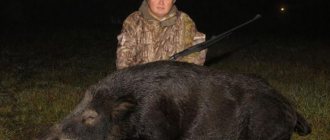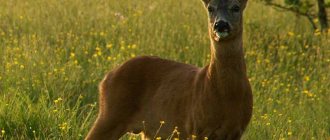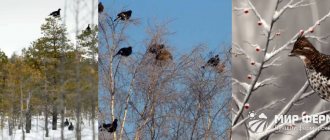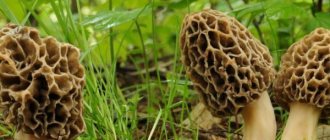- August 29, 2018
- Hunting
- Natali Michaelis
Hunting for elk during the rut is usually called hunting for wabu. This activity has become very popular over the past decades and has become truly widespread. Hunting elk during the rut requires a person to have enormous endurance, resourcefulness and skill. This is an incredibly exciting and exciting activity, but at the same time dangerous for an unprepared hunter. The thrill of elk hunting on wabu is simply indescribable. You will never understand all the delights of this business until you take part in it yourself.
What does the elk rut mean?
Shortly before the start of the rut, the bulls begin to moan to the cow. To do this, they quite often go out into open spaces, such as river banks or the outskirts of raised swamps. By the beginning of the rut, moose already have fully formed antlers and eye anterior processes called tusks appear. By the time the females begin their first estrus, the males have completed cleaning their antlers of velvety fur, which completely covers them. The male may follow the cow by snorting or snoring, and in some cases by tracks.
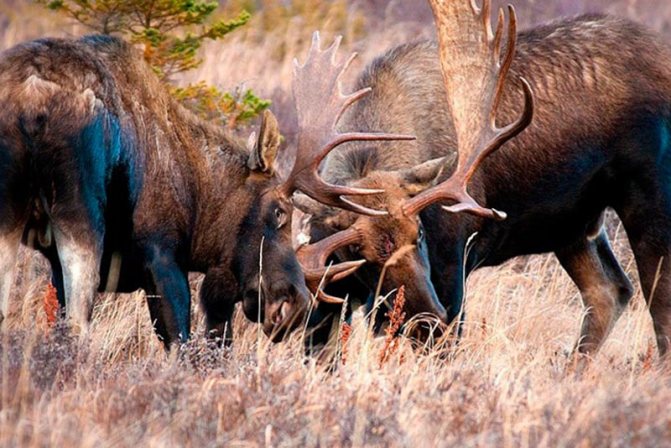
Why is hunting elk during the rut considered a dangerous activity? This is due to the fact that males during this period are very active and mobile. In most cases, they will behave aggressively towards humans. During the rut, bulls become incredibly crazy: they engage in brutal fights with other males for territory, uproot bushes, and break small trees. The winner of such competitions has the right to stay with the female, and the weaker ones go to look for a mate nearby. From time to time, the bull can drive away other males who dare to approach his “chosen one” at a fairly close distance. During the rutting period, the male follows the female on the heels and periodically makes moans. During this time, one male is able to cover up to four cows, but moose in most cases remain prone to monogamy.
How to lure a moose correctly
Once a moose's breeding area has been discovered, the easiest way to get it to shoot is to lure it there by making sounds of an opponent or a female. In addition to the voice, it is advisable to rustle branches and bushes, stomp, tap and scratch the bark of a tree, imitating the sounds of an elk breaking through the forest.
Voice and hands
If you want to call a moose, it is best to imitate the call of a young male. Other bulls respond to such a groan much more boldly. By the beginning of the rut, some males do not have a mate, so they more actively follow this sound, wanting to find a free female or fight her off from another.
The sound itself resembles a muffled groan, turning into a restrained roar. It is quite possible to learn to imitate it with your mouth; the secrets here are not so much in the technique of execution, but in the presence of hearing and some abilities. At the same time, they help themselves by pinching their nose with their index fingers, folding their palms into a mouthpiece and changing their position to change the volume and tone of the sound.
Video: How to lure moose during the rut
How to learn to roar like a moose
If you listen carefully to the roar of a rutting elk, you will notice that during this period the groan of adult bulls is similar to the sound of “oo-a” or “oo-o”; it is a dull roar. But the moo of young males sounds like “oh-uh”, its timbre is vibrating and rattling. During the rutting season, you can also hear the cry of a moose cow. This sharp sound, similar to a neigh, is often a response to the bold actions of a bull.
Read about how to hunt elk from the approach in winter.
On the waboo
It is much easier to call a moose using a waba - a special decoy. You can either purchase them or make them yourself.
How to make a moose waboo with your own hands
The simplest waba is made from a tin can. To do this, it is advisable to use not an ordinary tin can, but a can with a removable tin lid, from coffee, baby food, etc. The main thing is that the diameter of the upper hole, due to the rims, is slightly smaller than the diameter of the can itself. In addition to it, we will need a lace or nylon rope, 50–60 cm long, electrical tape or a piece of leather.
The waba is done simply:
- A hole is made in the center of the bottom of the jar so that the existing rope fits tightly into it;
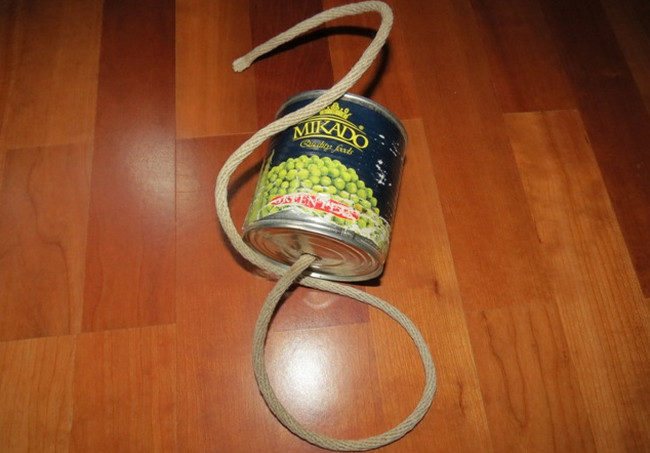
- We pass the rope inside and tie a knot at its end that prevents it from falling out of the jar;
- To make the sound of the vaba muffled and not cause metallic rattling, the walls of the jar can be covered with electrical tape or leather;
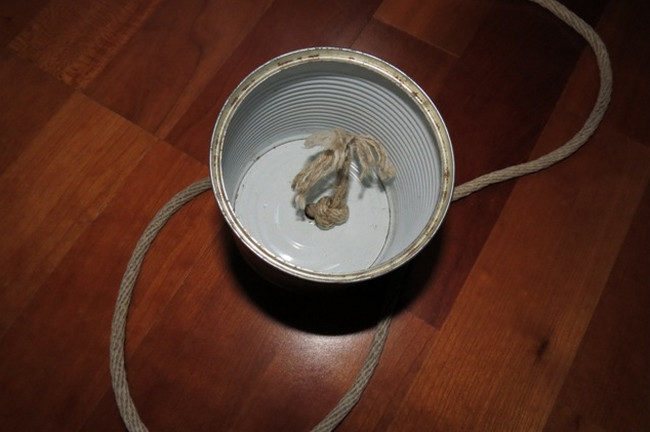
- Waba is ready.
How to attract you:
- The rope is wetted;
- The jar is taken with one hand by the base;
- With the other hand, pass along the rope from top to bottom, holding it tightly with two fingers.
In this case, the rope serves as a resonator, and the can as a speaker. You can find the desired timbre by filling a jar with moss. The smaller the diameter of the can, the higher the sound produced.
Video: How to lure a moose to a waboo
Elektromankom
Another convenient way to lure elk is an electronic decoy. This is an industrial device powered by batteries, in which a music library of various sounds made by moose is recorded: adult and young males, females in search of a male and during mating, the sounds of a fight, the roar of a rival male, etc.
However, when purchasing such a decoy, you must definitely listen to how the moose roar in this music library to make sure that the sounds are naturally similar. Often devices made for hunters in other countries are not very suitable for ours, since the sounds made, for example, by Canadian moose, are different from domestic ones.
Deadlines
Hunting for elk during the rut is limited in time, which in most cases depends on the climatic characteristics of each region. In Siberia, central Russia, the south and the European part, the high season is mid-September. But in the northern regions, intense rutting occurs from the end of September to the end of October.
As a rule, the rut begins when there is a large difference between daytime and nighttime air temperatures. The arrival of the first frost also indicates that it is time to go hunting.
Weapon and shooting position
When choosing a position for luring a bull and shooting, you must remember that the animal must pass through at least a relatively clean place in order to be able to target the slaughter area. As in any other case, you cannot shoot through thickets (branches, bushes, grass, etc.).
What weapon can be recommended for such a hunt?
From rifled - better than 9 mm caliber. These can be carbines chambered for 9.3x62, 9.3x64, 9.3x57 foreign-made, 9.3x64 and 9x54R domestic. A combined weapon is preferably with a rifled barrel chambered for the 9.3x74R cartridge or the above-mentioned domestic cartridges. It is better to use 12 gauge smoothbore weapons with cartridges loaded with heavy Brenneke-type bullets. All the cartridges that have been mentioned have sufficient killing and stopping power for such an animal as a bull elk during the rut, and I took the liberty of recommending them for the following reasons. Firstly, by the time of the rut, elk reach their highest fatness, and among bulls actively participating in the rut, specimens over 400 kg live weight are not uncommon; secondly, the cartridge must provide a reliable kill, because hunting takes place during the snowless period, and catching a wounded animal without dogs in the autumn forest, and often at dusk, is not at all an easy task; thirdly, by the time of the rut, animals become especially strong against wounds, since all the body’s reserves are mobilized to continue the race. It is advisable to equip the weapon with an optical sight, because you often have to shoot in low light, although the shooting distance rarely exceeds 60-70 meters.
Alexey Sibirsky
Video: Master class “How to lure a moose correctly”
Signs of the start of the rut
Here are some circumstances that may signal the start of the rut:
- Traces of bulls on clearings and roads are found noticeably less often than usual.
- “Mochetochki” and “digging holes” appear - rutting pits that bulls create while digging in these places. The “ureters” represent a kind of “mark” made of urine, which the male leaves on the tree in order to mark his territory. As a rule, the location of such marks does not change from year to year.
- “Notches” and creases appear on the trees - marks that remain on the bark when the bull scratches its antlers on it, tearing off the antlers from them. Most often, males scratch off the antlers at a height of one to one and a half meters along the entire circumference of the tree. It is simply impossible for an experienced hunter to miss such a trail.
It is worth paying special attention to these external signs during a driven moose hunt. Animal behavior provides the observant hunter with important information that can make finding an elk much easier.
Search for moose
A day before the start of the hunt, the receiving party conducts reconnaissance. This is the task of the rangers, who know the land like the back of their hand. The search party is led by an experienced tracker. On skis, he passes through a section of the forest where the drive will take place. By counting the entrance and exit tracks, the presence of the animal is established. But more often than not, it is not worth carrying out a full reconnaissance, since huntsmen should be well aware of the elk’s camping sites, which do not change radically.
To search, huntsmen use not only skis. Modern technology comes to the rescue: tractors, snowmobiles, ATVs. Or any other vehicle capable of traveling off-road.
How to choose an object for hunting?
Have you ever thought about when is the best time to start hunting elk during the rut? The roar of the elk, which should be heard at a great distance, should signal the start of the event.
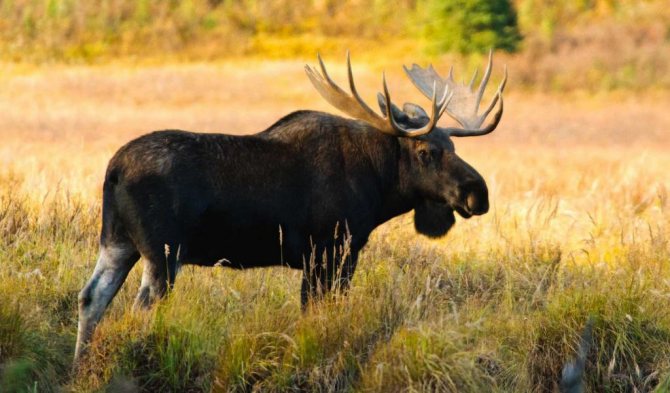
In hunting, it is extremely important to maintain the age composition of the elk population. For example, old males quite often scare away sires from young cows, which significantly impedes the normal reproduction of moose. First of all, when hunting, it is necessary to shoot old individuals, but young bulls with small and beautiful horns are better left alive.
Old individuals can be distinguished from young ones by their enormous growth, as well as degraded or ugly horns with much fewer processes. The groan of adult bulls is rougher and lower.
The best time to hunt elk during the rut is a relatively short period of ten days. For older moose, the rut begins a little earlier. This can be determined by the fact that they have become much more aggressive towards other males. An experienced hunter will always first choose the object that is most dangerous to other animals. First, you need to alternately attract different bulls over the course of a week. After which you will need to select the most suitable specimen and start hunting for it.
Characteristics of moose
Elk is the largest representative of the deer family found in the forests of central Russia.
Appearance
The animal looks very impressive. Its height reaches 210 centimeters, and its body length is 320 centimeters. The weight of adult males ranges from 350–700 kilograms.
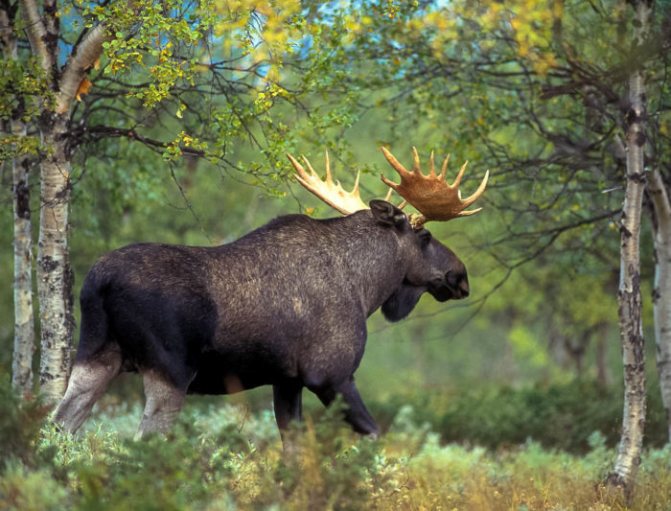
The moose has great strength and endurance. Its head is large, with a slightly elongated shape. The upper lip hangs slightly over the lower jaw. The head is crowned with large, spade-shaped horns. They are dense and act like weapons. Horns are also an addition to the hearing organs.
Interesting fact! The popular name for elk - elk - comes from the similarity of the animal’s silhouette with a plow, which used to be an agricultural tool among peasants.
Moose behavior in nature
The natural behavior of moose is a combination of caution and slowness. However, an angry animal can reach speeds of up to 60 kilometers per hour. In addition, moose swim well and are able to overcome up to 20 kilometers in water.
In winter they get rid of their horns, but after 3-5 months the horns grow back. Females do not have horns.
Important! The weakest point of a moose is its nose. The wolf knows about this vulnerable area, so the predator tries to cling to the nose.
Moose prefer to live in forests, and, if possible, move from deciduous to coniferous lands. The animal spends most of its time migrating between two types of territories—fat areas (feeding area) and bedding areas (resting area). The elk creates beds in order to reduce to a minimum the possibility of sneaking up on it unnoticed. The animal will prefer a hill to a lowland in order to see all the approaches to the bed.
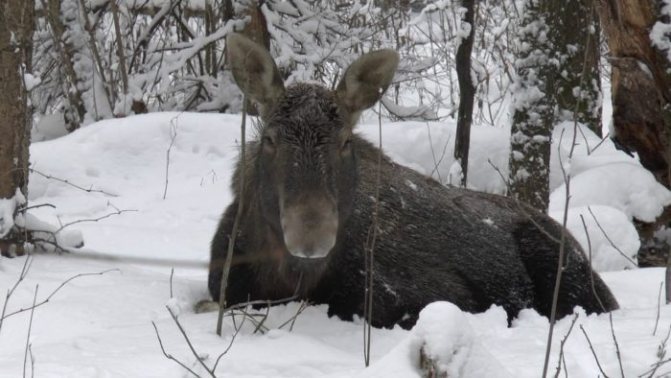
Elks are herbivores; they are capable of absorbing up to 50 kilograms of greenery per day. Animals consume tree shoots, river algae and forest berries. Eating usually occurs when the sun has already set or before dawn. During the day, the animal rests, digesting the food consumed. The mobility of elk is greatly influenced by air temperature: in very cold weather, the animal moves much less than usual.
Before the onset of autumn, moose live as hermits. However, males find females to mate with. The struggle with competitors for mating begins. Sometimes fights can be very brutal.
A moose cow gives birth to 1-2 cubs, which remain with her for about 2 years. During this time, the moose calves grow and become sexually mature. Young moose separate from their mother and begin an independent life.
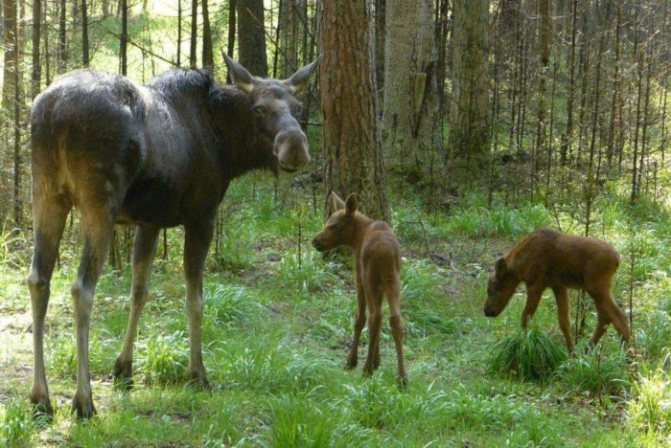
The lifespan of an elk is 20-23 years. However, an elk can live that long in captivity, but in the wild, due to exposure to various external factors, the average lifespan of animals is significantly reduced.
Selecting a location
The best places to hunt wild moose are their ruts. Most males will stay close to their grounds. Signs that moose are often found in one place are torn out bushes, trampled ground, bent trees, broken branches, and so on. The shooting location must be chosen in such a way that it offers a good viewing radius, but hides the hunter in the wilderness. Most experienced hunters prefer to choose several convenient shooting positions at once, after which, depending on the behavior of the animal, they can move from one point to another for a more convenient shot. The best option for moose hunting remains the help of a partner. So one person will participate in the role of a shooter, and the other - in the role of a lure.
Hunting safety rules
How to hunt elk correctly and as safely as possible?
There are the following rules of conduct when hunting:
- Shooting at an unclearly visible target is prohibited. As a result of non-compliance with this rule, real people may find themselves under fire.
- Exercise extreme caution when shooting. While waiting for the desired animal, the hunter can mistake any moving object for it and shoot at it by mistake.
- Shooting in the dark is especially dangerous. If visibility is poor, a hunter may confuse the target and shoot at a person. There are many such cases with fatal wounds in practice, so extreme caution is a guarantee of preserving the life of every hunter.
- You need to load the gun before the hunt itself, and unload it immediately after it ends.
- When hunting large animals, it is worth considering that they pose a particular danger to humans.
By following simple rules, the hunter will be able to get an enviable trophy without causing harm to himself or others.
How and when to hit?
The best time for a hunter to arrive at the rutting pits is early in the morning (thirty minutes before dawn) and evening (an hour before sunset).
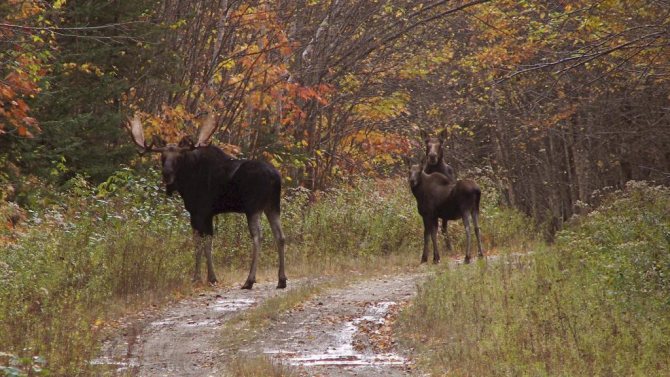
Such hunting is considered most productive only during daylight hours, and with the onset of darkness, luring must be stopped. If the elk responded to your bait while it was still dark, then you should leave this place and try your luck in another area. If you are unlucky there, then return to your previous position. Such dashes from one place to another are considered normal among experienced hunters, so you shouldn’t be surprised by this. If you don’t want to wait for the right time of day to shoot, then you should get an optical sight on which a night vision device will be installed. With such a unit you can hunt elk even at night. Moreover, you will perfectly see your prey, but it will not see you.
What to lure with?
To lure elk to a certain place, experienced hunters recommend using special electric decoys, the range of which can reach several kilometers. The most seasoned hunters know how to imitate an elk with their voice, but such sounds will only be heard from a short distance. Hunting elk during the rut with an electric decoy has a number of advantages over the old “old-fashioned” method, so many recommend not sparing any expense to buy such a device.
If you still decide to act the old fashioned way, then you need to know the basic sounds that can lure a moose to your position:
- crunch and crackle of breaking branches;
- the voice of a bull, similar to the croaking “oo-o” or “o-o”;
- the sound of protest from a middle-aged or young female;
- the voice of a bull, similar to the grunt of “oooh”.
Between each signal during the wub, it is necessary to maintain short pauses. First, it will be enough to make one sound, and then wait in silence for about 5 minutes. Then the intervals are reduced to one minute, the volume is increased, and the number of repetitions increases. It is also necessary to change direction regularly, unless, of course, you know for sure which direction the elk will appear from. If the animal does not respond, it is recommended to try to lure it with another sound or use an electric beacon.
Moose nutrition
Elk is a herbivore, capable of eating up to 50 kg of green food per day. The main food for moose is young shoots of trees, various grasses, aquatic plants and berries.
In summer, moose food mostly consists of leaves and shoots of swamp willow, birch, ash, aspen, rowan, maple, linden, oak, pine and spruce, as well as young reeds and reeds. In the swamps it eats heather, cotton grass, and horsetails. In May and June, horsetails and dandelions are the main food of moose.
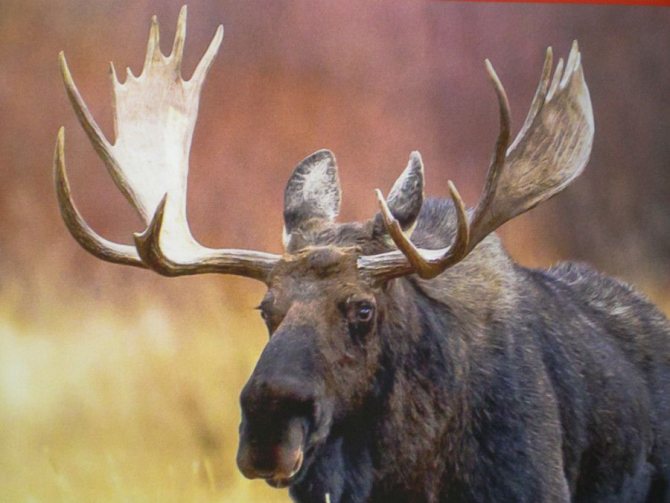
In Siberia, the main food of elk is the shoots of dwarf and bush birch. Elk very deftly break off branches using their long upper lip. When stripping bark from trees, elk deftly use their teeth as a chisel, tear off a piece of bark, grab it with their lips and teeth, and pull it upward with a long strip. Moose need large amounts of water and must drink a lot to quench their thirst.
The elk feeds mainly at night and before dawn; during the day, the elk rest, digesting the food they eat.
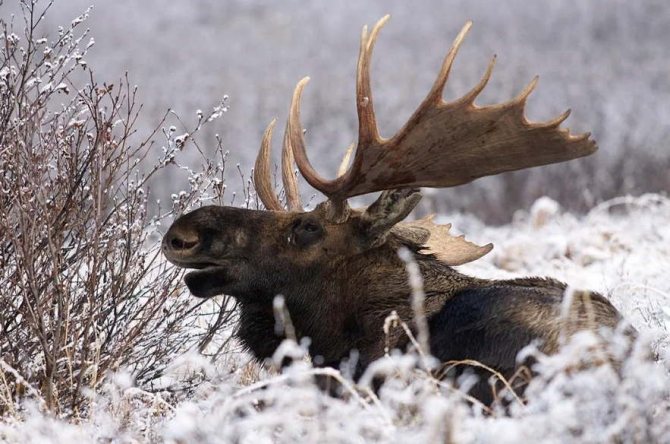
In the warm season, moose prefer to stay in the coastal strips of rivers, lakes and swamps, where they find a lot of fresh green food. In summer, moose spend a lot of time feeding in the water of various reservoirs, holding their breath, they dive under the water and collect nutritious rhizomes of aquatic plants. Moose go into the water not only in search of food, but also to protect themselves from mosquitoes, gadflies and other insects that cause a lot of trouble for moose on land.
The mobility of an elk is greatly influenced by the ambient temperature; in very cold weather, the elk tries to move as little as possible.
What to do after a successful boot?
If the elk responds to the waboo from afar, then you should continue to lure it until it comes close enough to shoot or appears in the shooter’s field of view. If the elk comes too close to the jacker, then you should immediately fire a shot, since hunting an elk during the rut is a rather dangerous activity. A racing elk is a fairly aggressive animal that can easily injure a person if it takes him by surprise. In this regard, every hunter is recommended to always be prepared and keep a loaded weapon at hand.
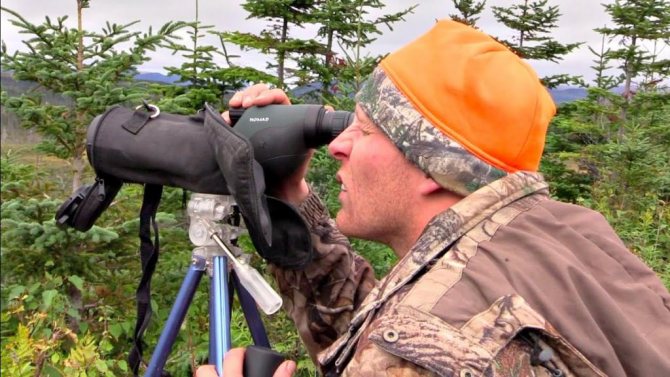
If the elk still doesn’t come out, you can try to take it from the approach. However, it is necessary to approach the animal from the leeward side, and you should move along to the “song”. Aim for the elk's head or the area between the shoulder blades. If you managed to overwhelm but not kill the animal, then approach the wounded elk only from the side, as it can hit you with its horns.
Activity of male moose by rutting period
Adult bulls are active and ready for mating throughout the rutting period , but in young males the development of gonads is delayed by 15-20 days. The dynamics of bull activity during the breeding season did not entirely coincide with the nature of gonad development. There were separate periods of rise, stabilization and decline in male sexual activity. Probably, in addition to individual factors (physiological state, age), their activity was influenced by external environmental factors, in addition, population indicators such as population density and population structure. We were able to clarify some aspects of this issue in the process of studying the rut in the Kirov region.
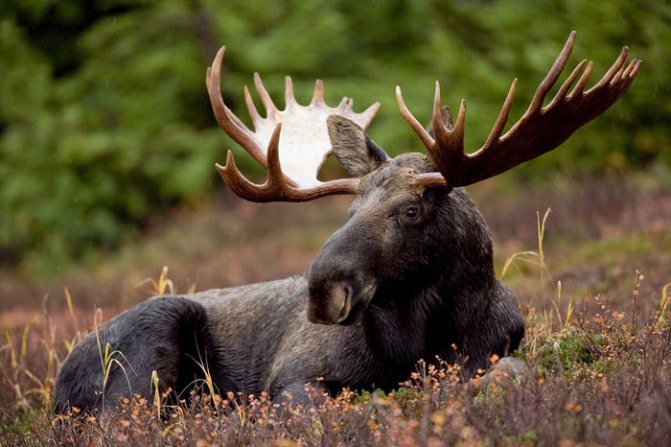
One of the significant factors in the dynamics of bull activity is the weather. The influence was exerted by precipitation, air temperature and wind. It is probably not entirely accurate to say, as A. S. Rykovsky (1965) does, that rutting activity decreases under the influence of weather factors. We have seen in practice that the elk race that has begun, like a running clock mechanism, does not stop and is not interrupted until the last female in heat is covered, and this should be emphasized. This is confirmed by the facts of covering moose cows in November and even in December. Another thing is that the external manifestations of the rut, for example, vocalization, change when weather conditions change. Often, a change in weather and the onset of a rainy season coincides with the movement of rutting elk from open areas to adjacent dark coniferous plantations. Animals can be more difficult to spot. The wind and the sound of rain drown out the waboo and the voices of moose. However, if by chance you manage to get close to the moose so that the answering voice of the bull can be heard, you can get the animal to approach and kill it. Observations have shown that in cloudy, windy weather, the responses of bulls to waba are 5-7 times less than in dry, windless weather. Our assumption about the reason for the passive behavior of bulls in rainy and windy weather was confirmed in the experiment, when the jacker gradually approached the rutting area, raising his voice every 30-50 meters, and a second person visually observed the cow and the bull located at the edge of the spruce gap. The behavior of the bull showed exactly when he heard the waba. 40 seconds after this, he “grunted” and took several steps towards the picker, who at that time was about 150 m away.
The number of bulls' responses to waba increased significantly in frosty, calm weather. In such weather during the day, as a rule, it is sunny and warm, and at dawn the temperature drops to minus 2° - minus 5°C. The number of responses from bulls increased by 7 times at morning dawns, and by 3 times at evening dawns. Experiments showed that the response voice of a bull can be heard in such weather at a distance of up to 1500-1700 m. It can be assumed that the bull hears a waba at this time even greater distance. Only this can explain the “great activity” of bulls in frosty, calm weather. In fact, activity remained constant. The range of sound signals simply increased.
In addition to the influence of weather conditions, some general periodicity in the activity of bulls during the breeding season was revealed. We summarized all the results of moose hunting for 7 observation seasons. The influence of weather factors with this approach was smoothed out, since on the same days in different seasons the weather was not the same. The activity of bulls gradually increased from August 25 to September 15-17, after which it decreased slightly until September 24, and from September 25 to October 5-10 it increased again, but did not reach the value of the first peak (September 17). Based on materials from S.V. Buslaev, the average date of production of 20 bulls was 1993-2003. falls on September 18th. It is characteristic that in both the Kirov and Ivanovo regions, from October 10, animal activity gradually decreased until October 25-30. These dates coincided with the last cases of bulls approaching the waboo. We believe that the identified periodicity in the activity of bulls is natural and is explained by different periods of puberty in young and adult females and the existence of repeated cycles in females that were not fertilized in the first sexual cycle. It is possible that the peaks in the physical activity of bulls did not coincide with the peak coverage of females. In the work of R. Claveou and R. Courtois (Claveou, Courtois, 1992), when determining the mating period of moose by the presence of sperm in smears taken from the genital tract of females, it was established that the first registrations of sperm occur on September 15, the peak of occurrence is on September 5 -October 15, and the last meetings are at the end of October. In young females (1.5-2.5 years), all dates of occurrence of sperm in smears are shifted to a week later. The conclusions of these authors indicate that the rutting dates for Canadian moose are somewhat later than in our observations and in studies of the elk rutting in North America (Altmann, 1959), but do not contradict the feedback between the start date of the rutting season and climate severity that is natural for the entire moose range . It is possible that the differences were to some extent a consequence of different methods for assessing rutting activity. In addition, not all facts and observations can be “deciphered” and assessed objectively. S.V. Buslaev says: “October 31, 1993. Temperature around zero. The day is clear, but the wind is strong. By evening it became quiet. Full moon. Sitting on a tower waiting for the wild boars to come out to the feeding area at 1710, I heard the voice of a bull at the edge of the forest 100 m from the tower. Then I saw a large bull with shovel horns. He slowly began to cross the field. I beckoned with a “croak.” The bull did not respond, but stopped, began to look at the tower, and then began to approach. Having reached my trail on the snow-covered field and sniffed it, he sharply jumped over it and quickly disappeared into the far corner of the field. After 10 minutes, 5 more moose, all males, entered the field one after another. A very large bull with branchy horns walked ahead. The rest of the horns were smaller and barely visible through binoculars due to the onset of twilight. Two moose actively vocalized and periodically locked their antlers. I beckoned, and the first elk silently took a few steps towards me. The others froze in place. The big bull reached my trail, calmly stepped over it, and after walking 3 m, he stood and stared at the tower. The rest of the moose sniffed the trail for a long time, not daring to cross it, then suddenly jumped over and began to catch up with the first one. At 250 m the whole group stopped, and the voices of bulls and the sound of horns were heard again. Soon the moose disappeared into the forest. The next morning, having followed these moose “at the heel”, 1 km from the evening meeting with them I found three areas trampled by moose with “torn” growth and mixed earth with snow. Except for the snow, everything looked like a classic manifestation of the rut. In September, there were no signs of rutting in this area.” During the winter period (November-December) I observed similar behavior in half-adult males, which I interpreted as a way of establishing subordinate relationships (hierarchy) in unfamiliar animals - migrants.

Since the success of reproduction primarily depends on the probability of meeting sexual partners during the female’s sexual cycle, their physiological and sexual maturity (i.e., on the age of the partners), the question naturally arises whether population density and sex ratio in the population influence dynamics of rutting activity. In general terms, such a connection is visible both from my data and from the materials of SV. Buslaeva. Long-term stationary studies showed that not only density itself influenced rutting activity, but also the sex and age composition of the population, which in turn was determined by fishing intensity. The population density of moose at the station from 1964 to 1971 ranged from 2 to 4.8 individuals per 1000 hectares of forest land. Production during the winter season amounted to 8-10% of the population recorded in March. The average age of harvested moose was 3.8-5.5 years. In the subsequent period, the moose population density increased, reaching 7-15 individuals per 1000 hectares, and the harvest rate was increased from 1981 to 12-14%. The average age of elk killed per season was 4.3-4.5 years in 1972-1981, and 4.3-2.6 years in 1982-1989.
For the first ten years, harvest was less than 10% of the recorded population, and there was a relatively low level of poaching. During this period, there was an accumulation of old animals in the population (from 0.3 to 2.7%) and an intensive increase in numbers. With an animal harvest rate of 12%, the proportion of old animals stabilized at a high level (2.0-2.5%)), but with an increase in the harvest rate to 14% (1983-1990), the proportion of old animals began to decline sharply. The average age of animals in the sample decreased almost by half (Fig. “Density...”). Population density also began to decline. Taking into account that the age composition of moose caught at a station using the trapping method did not have significant differences with the composition of the population, we can assume that the composition of the population changed in a similar way. The impact of these changes on the timing of mating can be judged from the analysis of the reproductive tracts of females aged 4.5-9.5 years, caught from November 10 to November 25. Females of these age groups are the most fertile. The results of their reproduction are less influenced by environmental factors, therefore the size and weight of embryos in females of these age groups almost completely depended on the timing of fertilization. In the period from 1966 to 1972, the average embryo weight was 5.4 g. In the period from 1974 to 1986, it increased to 14.5 g, and in 1987-1989. decreased to 8.6 g (Fig. “Dynamics ...”). According to K.M. Kurnosov (1973), who studied the dynamics of the development of elk fetuses, the age of the embryos, corresponding to the obtained values of their mass, was approximately 40-45, 60 and 50 days, respectively. Comparing the graph of changes in the mass of embryos over the years with the proportion of old animals in the prey, one can notice that both periods with a reduced mass of embryos coincided with periods of low specific content of old males in the prey and in the population. If we take into account that it is the old males who are the first to begin the rut, create unique biological signal fields in the lands, and, in essence, determine the entire course of reproduction, it becomes clear why, with a decrease in their numbers, there is a delay in the start of mating of animals.

Moreover, the decrease in the proportion of old males in the population actually led to a change in the sex ratio among breeding moose. Even in moose populations with an undisturbed age structure, there were 2-3 mature females per dominant male. With a sharp reduction in the proportion of old males, a rapid restructuring of marital relations did not occur, and in this regard, apparently, along with a delay in the start of the rut, some of the females were covered by less productive males. This is evidenced by a decrease in the fertility of moose cows (since 1985) with a decrease in the proportion of old bulls in the population. The conclusion about the influence of the sex ratio of adult and old animals on the activity of bulls and the course of reproduction is supported by literature data. In Alaska, with a ratio of 28 males per 100 females, conception in females lasted for 48 days, but after three years of permitted hunting of females, as a result of which the sex ratio in the population leveled out, the females studied were pregnant in 17 days (Lent, 1974). It can be concluded that the activity of bulls during the rutting period depends on the population structure. In stable and growing populations with a high proportion of old animals, the rut occurs earlier and the bulls are more active. In rejuvenated elk populations, declining due to excessively high hunting intensity, with a low content of old animals, the rut is delayed due to the low activity of bulls. It would be useful to conduct an annual assessment of rutting activity throughout Russia. We discussed this topic with S.V. Buslaev, and he proposed to assess the activity of the rut in points, conducting daily observations for 10 days during the period of peak activity (from September 10 to 25). On a standardized distance segment of routes (3 km), laid in different parts of the farm or region and passing through moose rutting areas, the observer must record 3 parameters characterizing the rutting activity: sound activity, visual encounters, damage to trees and shrubs (destructive activity ), and then make a final assessment of rutting activity based on the sum of points. This methodological approach seems successful and should be kept in mind when drawing up a monitoring program to monitor the state of moose populations in Russia.
Security measures
Under no circumstances shoot at rustling or noise, but only at a target that you can clearly see in front of you. There were many cases when the second hunter came to the voice of the jacker, and he was shot. Hunting elk during the rut requires discipline, endurance and precision. Also, do not forget that the weapon must always be on safety. Going on an elk hunt during the rut and shooting yourself instead of the animal sounds quite ironic, and in some cases even tragic.
Hunting process
Drive hunting can be divided into several stages, including:
- Search for moose.
- Arrangement of the team of hunters on the shooting line.
- Arrangement of the team of beaters.
- The process of driving an ungulate animal.
- Shooting from rifle numbers at a moving target.
- Addition of a wounded animal.
Three to five shooters and the same number of huntsmen-drivers most often participate in elk drive hunting.
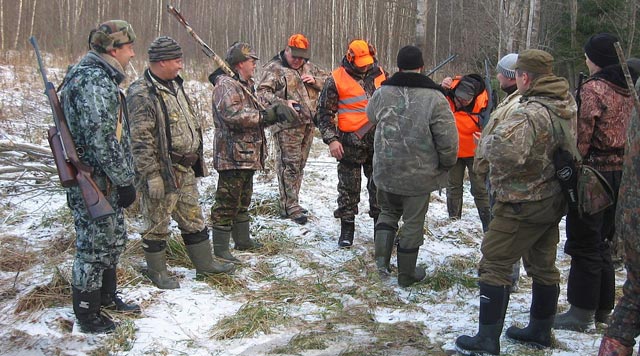
The final result depends on the coordinated work of all participants in the process.
One team must scare the elk and bring it to the shooters. The other team must get the trophy. But before that, you need to find the elk.
Moose hunting in summer
It is not customary to go moose hunting during the heat, since meat from shot game can spoil quickly, and the skin of animals is practically not valued at this time of year. In most cases, moose are killed accidentally in the summer, for example, by stumbling upon a dead moose cow with calves. However, some hunters prefer to guard males during the females' estrus, which occurs precisely during this period. However, such a hunt is unlikely to bring much value or pleasure.
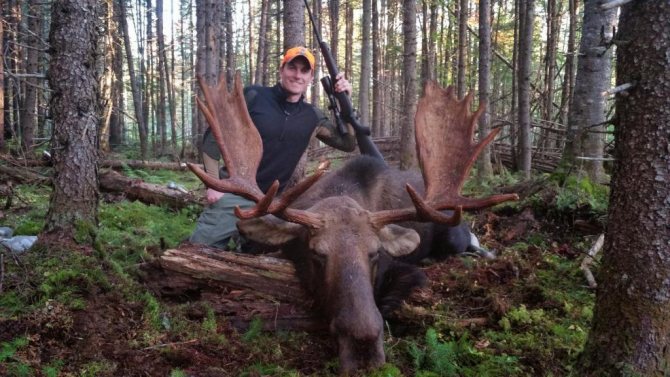
Hunting tactics
There are many options for hunting - driven, on salt licks, with dogs, with approach. They all give results, but hunting with a roar decoy is considered the most effective. Thus, many hunters unsuccessfully go on driven hunts for years without finding the animal.
Important! Roar hunting allows only one hunter, although it is better to go with a huntsman or in a group.
Weapons, position, equipment
Elk is a powerful animal that can kill a person. Sometimes life depends on the correct choice of a hunter. The gun should not be new, only one that has been shot will be convenient at the right time. Since the shot distance is short, you should take a smooth-bore weapon of 12-16 calibers. You can also take a 12-gauge rifled shotgun, although this option is also suitable for a longer shot. Rifle guns with good optics are the best choice for trophy hunting. For shooting at dusk, a night sight is useful.

The cartridges must also be reliable - from 308Win and more, 7.62 * 51, 9.3 * 62 are suitable, bullet weight - from 18 g. You can even take “elephant cartridges”, if the hunt is for a trophy, the result will be 100% m, but the meat will remain spoiled. In any case, the cartridges must have high destructive power. This is due to the safety for the hunter and the difficulty of finding a wounded animal during the snow-free period. By the time of the rut, animals become more resilient to wounds, which confirms the need for good ammunition.
When choosing a position, pay attention to the fact that the elk does not like to go out into open places. The animal prefers to move more often, so it is better to intercept it on the paths. When hunting is carried out in a group, they build a chain perpendicular to the movement of the animal, which is likely to stumble upon the hunter.
Slaughter places
The best killing spots are the area of the shoulder blade, the chest in the heart area. Usually, if there is a bullet of a serious caliber, the animal falls immediately. You can also shoot in the neck, lungs, spine, but you must be prepared to finish off the animal, which can still travel some distance due to excess adrenaline.
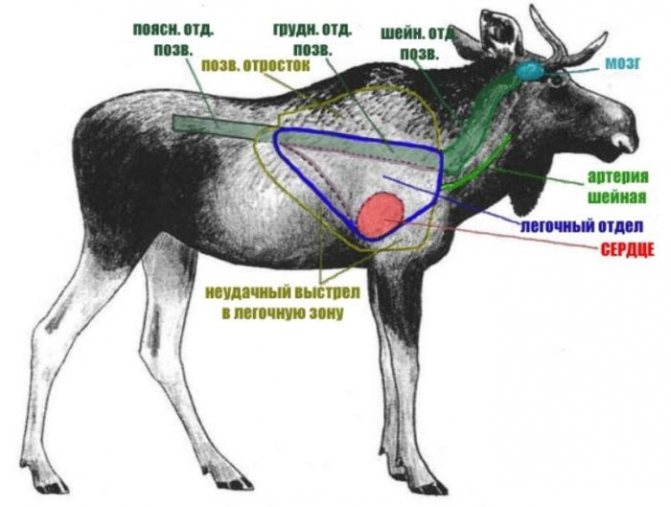
Hunting on ice
In some cases, moose are deliberately lured onto the ice, because the animals, after running just a few meters on the slippery surface, fall and cannot get up. However, it will be extremely difficult to implement such an idea. First, most areas will experience moderate weather during the rut and ice is unlikely to form. Secondly, it will be quite difficult to lure an adult onto the ice, since animals come to the reservoir solely to drink water, and it is best to carry out the bait near the rutting pits. However, if you manage to pull off such a trick, your chances of getting a well-aimed shot will increase significantly. The animal will not be able to attack the hunter, since it is not able to move quickly on ice, and it will not be able to escape either.
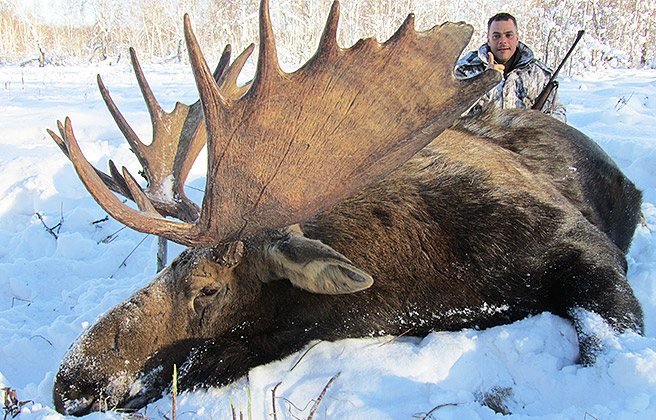
Ambush shooting
How to make a successful “trip” for elk? Hunting during the rut is a rather dangerous activity, so most hunters prefer to work in pairs or small groups. In such a team, everyone must approach their role with a great deal of responsibility. However, the most important actions are performed by the shooter. If he does not kill the animal with one cartridge or completely misses, then the hunt may take a bad turn. The sound of a shot can scare away an elk, and it will never appear in this place again, so a miss is unacceptable. At the same time, if the wrong caliber of cartridges is selected or the hunter only slightly touches the target, then an angry animal can attack the entire group of people. To prevent this from happening, it is recommended to use shelters.
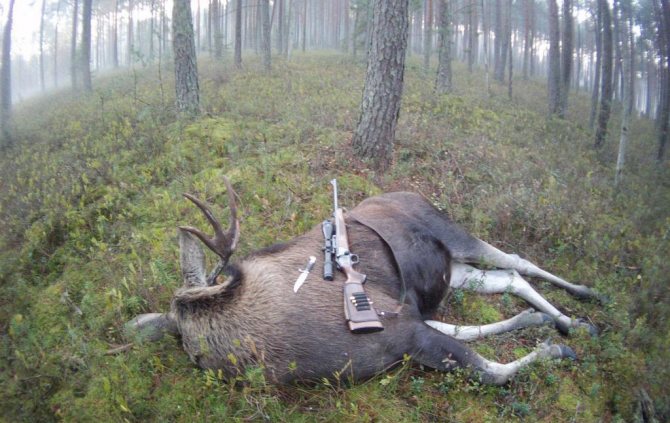
Hunting methods
There are several types of moose hunting: roaring, approaching, stealth hunting, hunting with a pen and with dogs.
On the roar (with decoy)
This hunting option is one of the most common. The active moose rutting season lasts from September 1 to September 30. The greatest activity of the rut is in the morning and evening. In rare cases, roaring occurs at night.
Luring an elk is a difficult task. Usually a decoy is used for this purpose; there are also special repellents that recreate the smell of a moose cow, to which males respond. However, it happens that the animal comes out to the hunter, frightened by some rustling or sensing odors.

From the approach
When approach hunting (there is another name for this method - walking hunting), the hunter finds an elk, approaches it within effective striking distance and fires a shot. No vehicles are used.
Note! In autumn, they hunt from the approach only when the first snow has fallen. The optimal time for approach hunting is from October to November.
There are several approaches:
- Classical. The hunter walks through the moose's habitat and, having found the animal, shoots.
- Hunting by tracking. The hunter follows the trail of the elk, and when he finds it, he fires a shot.
- Hunting by stealth.
- Drive hunting.
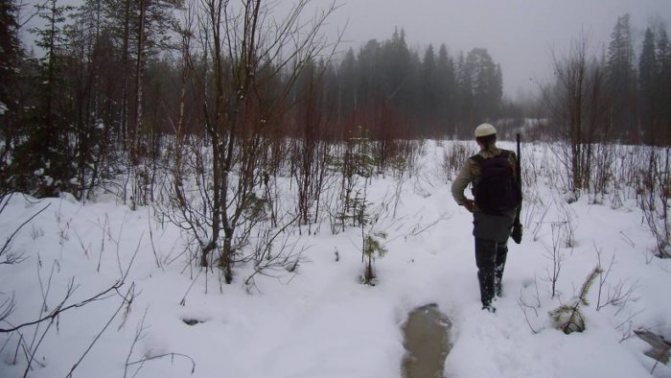
Hunting by stealth
The hunter knows where the elk is and sneaks towards it (hence the name - stealth). The hunter's task is to covertly (by stealth) approach within the distance of a rifle shot and hit the target. Your arsenal should include wide skis and a 12-gauge shotgun.
The best weather for stealth hunting is a clear, frosty and slightly windy day. The wind muffles extraneous sounds, which makes approaching the elk easier.
They go to the intended hunting site (usually an elk fattening area) while it is still dark. When it becomes lighter and the hunter is convinced of the presence of an elk, he begins to creep up to the animal within shooting distance. It is important to consider the direction of the wind. You need to approach against the wind.
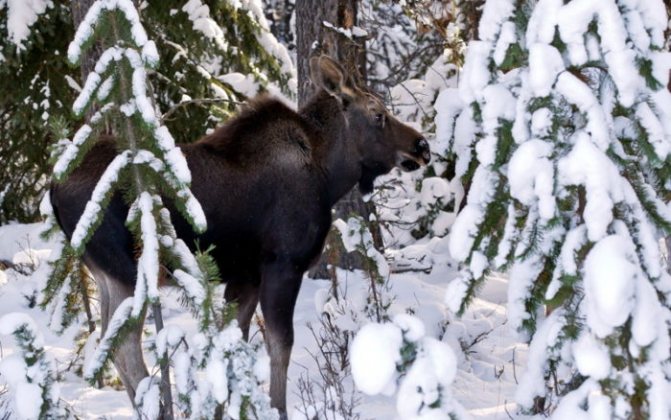
Hunting in a drive
Another name for hunting with a drive is drive. A group of hunters participates (usually 3-5 shooters and the same number of beaters). The success of the event is entirely determined by the coordinated actions of all team members. The goal is to scare the moose away so it goes after the neighbor, who is already waiting with a gun at the ready.
It should be borne in mind that it is impossible to accurately determine the actions of a moose at the moment of danger. In attempts to get out of the pen, the animal resorts to the most desperate actions.
When hunting in a pen, each number is allocated a place from which there is an overview of a fairly wide area. The hunter must thoroughly prepare for the event by trampling the snow around his position, otherwise at the decisive moment he may fall into the crust.
Hunting with dogs
Winter or autumn hunting along the black trail with huskies is a popular way of hunting elk. The best in this business are animal huskies. The success of the event is largely determined by the abilities and training of the dogs. They must hold off the elk, which is much larger than them, until the hunter approaches.
If you train the huskies correctly, then 2-3 dogs are enough to cope with the task. Having dogs near a moose does not mean that they will be able to hold it indefinitely. Moose are not too afraid of huskies and easily attack them. A dog without hunting experience can be injured and even die. Therefore, the hunter must move as silently as possible, but quickly,
Note! The queen is able to deliberately distract the dogs' attention, thereby allowing the moose calves to escape.
When in danger, the elk acts in the same way as it would if it encountered a natural opponent. A young healthy animal will go on the attack. When leaving, it will look for open space to maneuver. If the animal feels weaker, it will choose the most confusing escape route, inconvenient for the hunter and dogs.
Hunting with a husky is also carried out by following the scent. Having found an animal, huskies surround it and signal the hunter about this by barking.
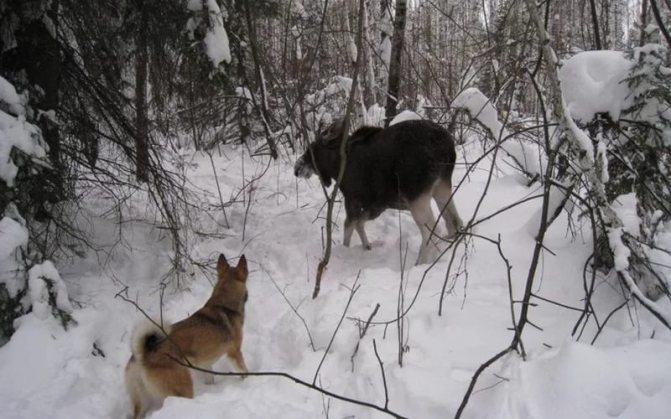
Hound breeds of dogs are not used in hunting ungulates. If a hound even once smells the smell of a killed elk, it becomes dependent on the rut and other types of animals cease to interest it. In order not to “spoil” their dog, hunters try not to take it to elk.
Hunting is also carried out with a dog on a leash. To do this, you need a specially trained husky, trained specifically for moose. A dog without barking leads the hunter to the animal. The hunter knows that the husky has sensed the elk by the tension in the leash.
Watch the moose hunting video:
Building a Shelter
To begin with, the sniper needs to take a good look around the area with the racing pits and find the ideal position for the shot. Ideally, it should provide a good viewing radius, but at the same time be well camouflaged. If natural shelters are not enough, then artificial ones can be built. To do this, use dried branches and foliage and build a mini-hut. In such a secluded place, the shooter can remain unnoticed for several hours. If he misses due to excitement or fatigue, the elk will not understand where the shot came from, which means that everyone will remain alive and well.
Now it’s clear what rutting elk hunting is. If you follow the recommendations from more experienced hunters, you will definitely be able to shoot a wild animal.
Moose slaughter places
To shoot at an animal as large and tough to wound as an elk, you only need to be at a confident shot distance, which depends on the type of weapon used by the hunter, the type of cartridge and the shooting skills of the hunter. The hunter should try to hit the elk with one precise killing shot so that the animal does not suffer for too long.
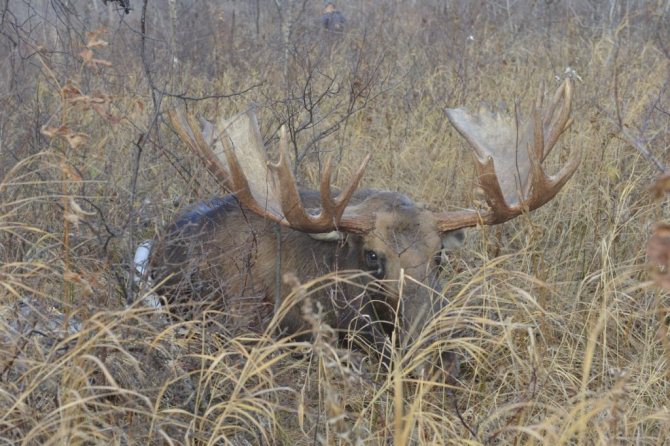
When hunting elk, you need to take into account the fact that there is no question of “life and death” when you always need to shoot at the target. If a hunter doubts the quality of the shot, then it is better not to cock the trigger, so as not to injure the animal again.
To be sure to hit a moose, you need to know where to shoot. An unsuccessful shot will result not only in a miss, but also in the presence of a wounded man, which is much worse.
Most often, shots are fired at the following elk slaughter areas:
- The subscapular region (heart and lungs are affected) is the most significant killing site for elk. It is located in the lower part of the elk's chest, at a level approximately 20 cm above its elbow joint. Even if the bullet does not hit the animal’s heart, deflecting 15-20 cm in any direction, it damages the elk’s lungs, which guarantees its rapid fall.
- Neck (aorta) - many hunters prefer to shoot at the elk's neck, in which case either the cervical vertebrae or the elk's aorta are affected.
- Head (brain) - a head shot should only be fired at a very close distance and from an accurate weapon, then there is a chance to kill the elk on the spot. The elk has a fairly powerful skull; a weapon of insufficient power may simply not penetrate it.
- Spine (spinal cord) - a bullet hitting an elk's spine will ensure it falls quickly. It is advisable to shoot at the spine from a not very far distance.
Determining the severity of an elk injury
If the elk does not fall immediately after the shot, the hunter must follow the trail left by the elk for at least 200-250 meters to make sure whether there was a hit or not.

By the nature of the traces of blood left by the elk, one can roughly determine the location of the hit and the nature of the animal’s injury. The location of the hit can also be judged by the behavior of the elk after the shot.
- If it hits the heart, the blood will come out in spurts; with such a hit, the elk will most often not be able to go further than 40-50 meters.
- When it enters the lungs, the blood is sprayed into small drops, in this case the animal will not go further than 200-250 meters. Red blood with bubbles indicates that it has entered the lungs.
- If blood does not appear immediately, but after several tens of meters, this most often indicates that the elk has been wounded in the muscle.
- If, after being shot, the elk tries to rise and stand on its front hooves, this indicates a hit in the spine.
- When hit in the head, the elk most often falls, convulses for a while, then jumps up and runs away.
- Dark blood indicates that the elk has been seriously wounded in the liver, spleen or kidneys and will not be able to go far.
- Blood on either side of the moose mark indicates that the bullet went straight through.
- If the elk noticeably humps after the shot, most likely the bullet hit the intestines; traces of feces in the blood also indicate that it entered the intestines.
- Pieces of fur can indicate where the bullet hit, if they are long and dark, the elk was wounded in the upper part of the body, and if they are short and light, the bullet hit the limbs.
A hunter should not immediately chase a wounded animal after a shot; it is better to pursue a wounded elk after 30-40 minutes. During such a time, the elk should not go far, having run a certain distance and not hearing anyone being chased, he will most likely lie down in some secluded place in order to rest, and if the wound is serious, he will die from loss of blood.
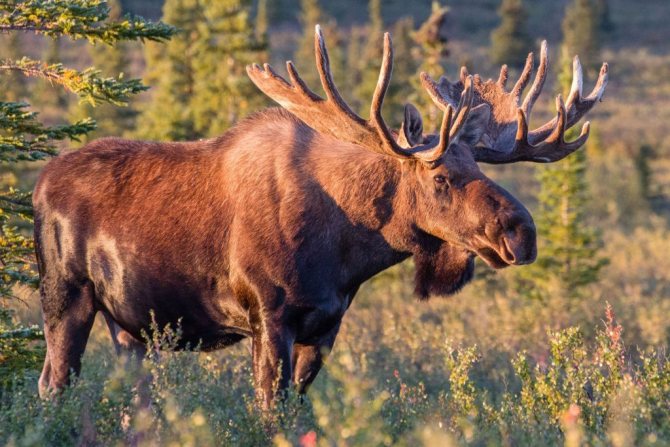
When approaching a hunted elk, you should be careful. When approaching an animal, you should keep a loaded gun at the ready. You should approach the elk from the back, because if the elk is only wounded, one blow from its leg will be enough to cause serious injury or even kill the hunter. When approaching a hunted elk, you need to carefully look at the ears, eyes and fur on the ridge. If the elk's ears are flattened, its fur is raised, or its eyelashes are moving, the elk is not killed, but only wounded. The easiest and most reliable way to finish off a wounded animal is to shoot in the area behind the animal's ear.






